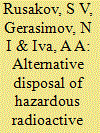| Srl | Item |
| 1 |
ID:
118339


|
|
|
|
|
| Publication |
2012.
|
| Summary/Abstract |
The authors describe a new thermal method for disposing of large hazardous radioactive and clean objects.
|
|
|
|
|
|
|
|
|
|
|
|
|
|
|
|
| 2 |
ID:
141927


|
|
|
|
|
| Summary/Abstract |
The author discusses the legislative and regulatory framework enacted to maintain nuclear, radiological, and industrial safety in an operation to dispose of Akula class nuclear-powered submarines. She examines the physics and chemistry of toxic and radioactive wastes and draws the conclusion that engineering and environmental measures of the decommissioning and disposal operation must be carried out to reduce environmental pollution and exposure of the personnel and general public to the minimum possible doses of radiation.
|
|
|
|
|
|
|
|
|
|
|
|
|
|
|
|
| 3 |
ID:
094209


|
|
|
|
|
| Publication |
2010.
|
| Summary/Abstract |
It is pointed out that the apparent decision of the United States to end development of the Yucca Flat, Nevada repository for permanent disposal of radioactive waste may inadvertently place it at variance with the disposal principles of the International Atomic Energy Agency (IAEA) which caution nuclear nations that "The burden on future generations shall be minimized by safely disposing of high level radioactive wastes at an appropriate time, technical, social and economic factors being taken into account." It is then shown that the IAEA's ten technical criteria for underground disposal can seemingly be met by storing vitrified waste a kilometer underground in the crystalline basement rock of a mid-continent shield, where: (a) it should be invulnerable to redistribution by incompetence, natural disaster, or terrorism and (b) there is no obvious pathway for leakage into the biosphere. Finally, a method is proposed by which the storage impasse may be broken.
|
|
|
|
|
|
|
|
|
|
|
|
|
|
|
|
| 4 |
ID:
133261


|
|
|
|
|
| Publication |
2014.
|
| Summary/Abstract |
Grid-connected solar photovoltaic (PV) power is currently one of the fastest growing power-generation technologies in the world. While PV technologies provide the environmental benefit of zero emissions during use, the use of heavy metals in thin-film PV cells raises important health and environmental concerns regarding the end-of-life disposal of PV panels. To date, there is no published quantitative assessment of the potential human health risk due to cadmium leaching from cadmium telluride (CdTe) PV panels disposed in a landfill. Thus, we used a screening-level risk assessment tool to estimate possible human health risk associated with disposal of CdTe panels into landfills. In addition, we conducted a literature review of potential cadmium release from the recycling process in order to contrast the potential health risks from PV panel disposal in landfills to those from PV panel recycling. Based on the results of our literature review, a meaningful risk comparison cannot be performed at this time. Based on the human health risk estimates generated for PV panel disposal, our assessment indicated that landfill disposal of CdTe panels does not pose a human health hazard at current production volumes, although our results pointed to the importance of CdTe PV panel end-of-life management.
|
|
|
|
|
|
|
|
|
|
|
|
|
|
|
|